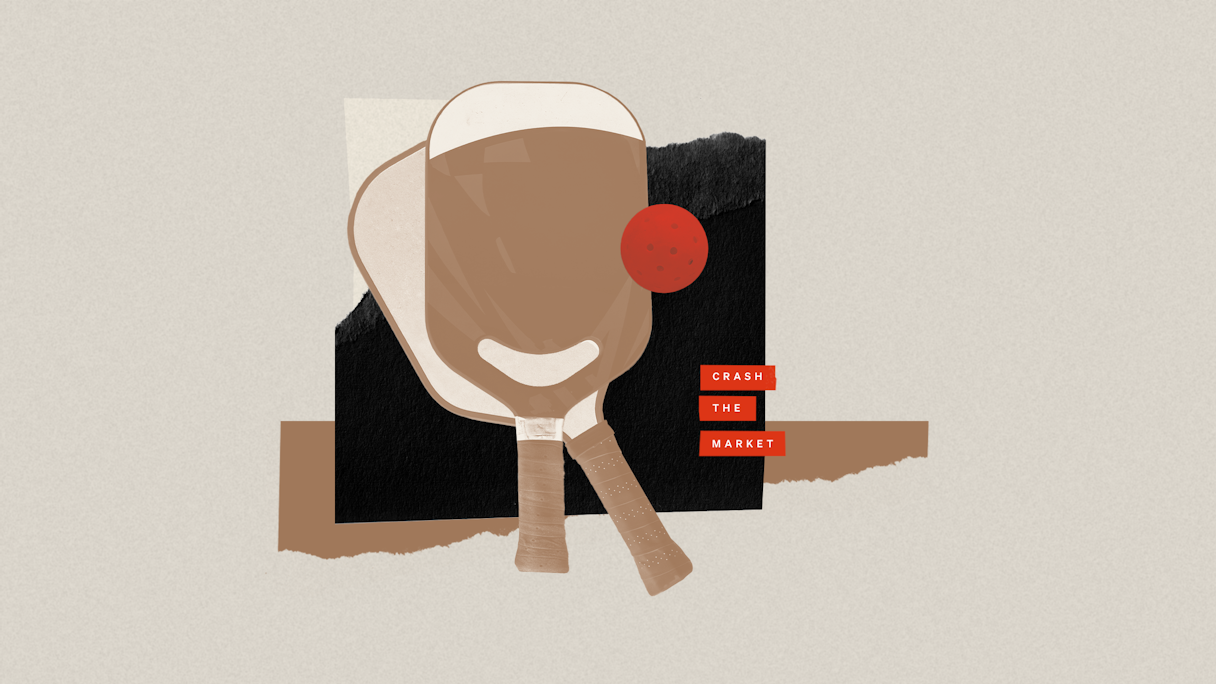Brand Strategy
Pickleball's "Grandma Jack’s" Branding Lesson for Tech

She’s salty. Seasoned. Wears those wraparound shades that are popular with outfielders — or The Terminator. And she wields a weapon you might not have heard of but won’t soon forget.
Meet Grandma Jack. At 95 — with her “thermoformed, edge wall-injected,” 7.6-ounce, 16-millimeter, T-700 raw carbon-fiber paddle named “The Filth" — she will kick your a** all over the pickleball court, from sideline to sideline, from the baseline to the kitchen line. Her drives? Drops? Dinks? Deadly. You’ve been warned.
Now, pop quiz: what stands out most about Grandma Jack? Our money’s on her age or the name of her paddle or the lethality of her game. It’s likely not the weight, size, and material of the paddle because, well, those things are ... technical. Table stakes, even. And when you consider that in 2023 alone, the USA Pickleball Equipment & Evaluation Committee tested and approved 1,185 new paddles, well, there are a lot of paddles out there with similar specs — and there are a lot of paddle manufacturers who try to brand their wares around them. That, friends, is a swing-and-a-miss. And the same sin too often committed by tech companies.
The quick takeaway: for tech companies battling a slew of competitors in a lightning-fast innovation marketplace, touting specs and features and "industry leading" status is a surefire way to blend in — and bore the hell out of people! But to get customers excited (and excited enough to make a switch), we can take a lesson from Bread & Butter and Grandma Jack, and invest in brand. We can take our brand and apply it consistently across our messaging and visual design and products. And we can stand out, because everyone else is too timid to lean in. No, we're not saying that all brands should apply the same humor and edge that Bread & Butter employs — that kind of persona is not authentic for every company, and savvy customers can smell a fraud. Instead, here's our advice: identify and hone your unique brand, because it will connect with customers and be remembered.
In that spirit, and knowing that pickleball is every bit (well, not really) as sophisticated as the B2B tech space, here's what we can learn from the brands leading the charge in America's fastest growing sport.
Grandma ain't no gimmick
It’s easy to watch Grandma Jack and say, "Yeah, she’s funny, but it's just marketing." OK. Fair. But forget fair. Here's what's true: great marketing isn't possible without a robust brand. This is not a chicken-or-egg argument. You can get as creative as you want with advertising and marketing, but if the brand is empty, well, you'll lay an egg. Womp, womp, womp. The reason Grandma Jack works isn't because she's funny — it's because she's symbolic. What do we mean by that?
Let's start with the greater Bread & Butter brand. This is a company that's irreverent, intelligent, tuned into pop culture, a bit self-depreciating, and ... kind of stuck somewhere between the 1960s and 1970s. Just look at those groovy colorways and fonts on the website and the paddles. They're not quite psychedelic, but they're definitely not the “Tron”/tech/too-much-of-the-same designs deployed by many competing brands. Check out the stylized ampersand in Bread & Butter’s name and notice how it melts — and discover that the brand has a paddle called, wait for it, The Drip. Click on the About Us page and see the glasses and headbands and hair. These folks want to have fun and execute some funky goodness on the court and seriously eff with opponents. Given those vibes, doesn't it make sense that Grandma Jack (who would've been in her first prime back in the 1960s or 1970s) is a viable brand ambassador? Yes. And there's more.
Consider what Grandma Jack symbolizes: experience. If you've ever played pickleball, you've likely been humbled by someone a generation or two older than you. And if you haven't played pickleball, you likely think it's "an old person's sport." Really, it's a sport where patience and precision can quickly close the gap — and often trump — athleticism and aggression. This is a game where positioning matters more than pace, where chess wins over charging forehands. With Grandma Jack, Bread & Butter confronts a pickleball stereotype head on and turns it on its head. The beauty of this approach? It's relatable to all ages, to both pickleball regulars and newcomers alike, and that helps broaden the appeal of Bread & Butter's products, be they paddles, overgrips, or hats.
Now, here are a couple of key points. Bread & Butter isn't competing on price (see Friday’s paddles, for that) or pure style (see Tangerine). What they're doing is marrying premium performance with unique style. Whether or not their paddles are the best isn't the question. Rather, Bread & Butter is asking the market, "Would you like a premium paddle with a little panache?" And whether it's The Filth, The Drip, The Loco, or The Shogun, a lot of folks are answering yes. And it's all on-brand.
Tip for tech brands:
- Jettison the jargon: While words and phrases like “seamless integration” and “omnichannel engagement” and “increased efficiency” have a place in product descriptions, they are table-stakes capabilities and benefits that are hard to build a brand around. Please don’t put them in your hero headline. Instead, focus on the emotional and experiential payoffs customers receive from your brand.
No. 1 gets overdone
Whether a sporting goods supplier or a meeting productivity SaaS technology, how many times have you seen a company trying to brand itself as The Brand That The Best Players Choose? Too many. Yawn. It's OK to appeal to The Best. It's not the best strategy to refer to yourself as "the industry leader." Why? Because very few brands can actually, authentically claim that title. Fewer still can own it in a way that's meaningful. And the best brands know not to lean too heavily on it — because it's fleeting.
Joola, long a ping pong (sorry, table tennis) brand, entered the pickleball marketplace with a splash in 2022 with the signing of world No. 1 player Ben Johns as its ambassador. Cool. Johns is, in a word, phenomenal. He's also human. And humans grow older and less effective and ... No Longer The Top Dog. So, what has Joola done recently (as in, this year)? Signed, in Barstool Sports' words, "the most electrifying man in sports," Tyson McGuffin to its roster. On the surface, Johns and McGuffin couldn't be more dissimilar. And we're not just talking about the tattoos. But here's why it works: from the start, Joola staked its claim as the premium choice for premier pros. And, damnit, they've backed it up. Do they tout their specs and tech? Yes. Do they feel a little “Battlestar Galactica” in their fonts and colorways? Maybe. Do they give their paddles god-like names (Perseus, Magnus, Scorpius)? Yup. Is that ... your thing? Maybe not. But at least they're consistent.
And at least they've thought ahead enough to realize how the best-est and the boldest can coexist within the brand, and open new possibilities to grow, authentically. Joola's signing of McGuffin is noteworthy because it illustrates a brand that continues to evolve, in a way that's true to itself.
Tip for tech brands:
- The top spot is tenuous: If you find yourself positioning your brand as “the largest” or “the best,” go back to the drawing board. Size isn’t permanent. Neither is status. And both beg questions of trust, factual accuracy, and proof. Instead, follow the old rule of “show, not tell” — and provide proof points that not only explain why you’re the best, but why you’re the best for your target audience. Get specific, not nebulous.
Crash the market with crack solutions
Selkirk (McGuffin’s former sponsor, by the way) seems to have solved a problem that has plagued pickleball players from the get-go: cracked balls.
Wait. The paddle might not be the most important part of the game? Maybe it's ... the ball? Indeed. And one that doesn't break after a couple of weeks. Or get overly "eggy" (where it becomes misshapen with age). Or isn't too mushy (like a sponge hitting your paddle). There are other challenges, but Selkirk’s Pro S1 debuted last year with a one-year anti-crack warranty and quickly became the go-to ball for many picklers.
When you look at the Pro S1 and consider some of the brand’s other offerings — like edgeless paddles with a hole below the face for quicker swing speeds, and Selkirk Labs’ experimental designs — there’s a story the brand can tell around innovation, future-think, and being first. And while there’s some of that language across the brand, Selkirk does a good job of not over-indexing on it. Why? Because just as size and status are fleeting positions, so too is Being The First.
Tip for tech brands:
- Your brand is bigger than your product(s): It’s not that products aren’t important; sometimes they’re revolutionary. But if you over-index on them and under-develop your brand, you’ll constantly be scrambling to reinvent your messaging and offerings every time a competitor copies you or bests you. Instead, develop a brand story and core messaging (think purpose, mission, and vision) that give your company meaning, to both your employees and prospective customers.
Grandma’s lessons are sick. And they stick.
On that last note — how other companies will try to copy you, both your products and your messaging — brand holds the key to staying power. And when we say “brand,” we mean everything. Strategy. Positioning. Logo. Typography. Visual language. Messaging: the public-facing prose, the internal philosophical stuff. And story. Story! All of this goodness working together creates a powerful narrative that dazzles the senses, piques the mind, and sings to the soul.
On a pickleball court, you might see someone holding a groovy-looking paddle and ask them about it. They might tell you it’s called The Drip, and that their dinks have never felt so … buttery. “Buttery?” That’s right. That’s how they talk. Rad. Maybe you’ll ask, “Who makes that thing?” It’s Bread & Butter. Who also makes The Filth. And then, it’s your turn to answer a question: “Have you heard of Grandma Jack?”
That’s story. That’s sticky. Ain’t nobody copying that.





